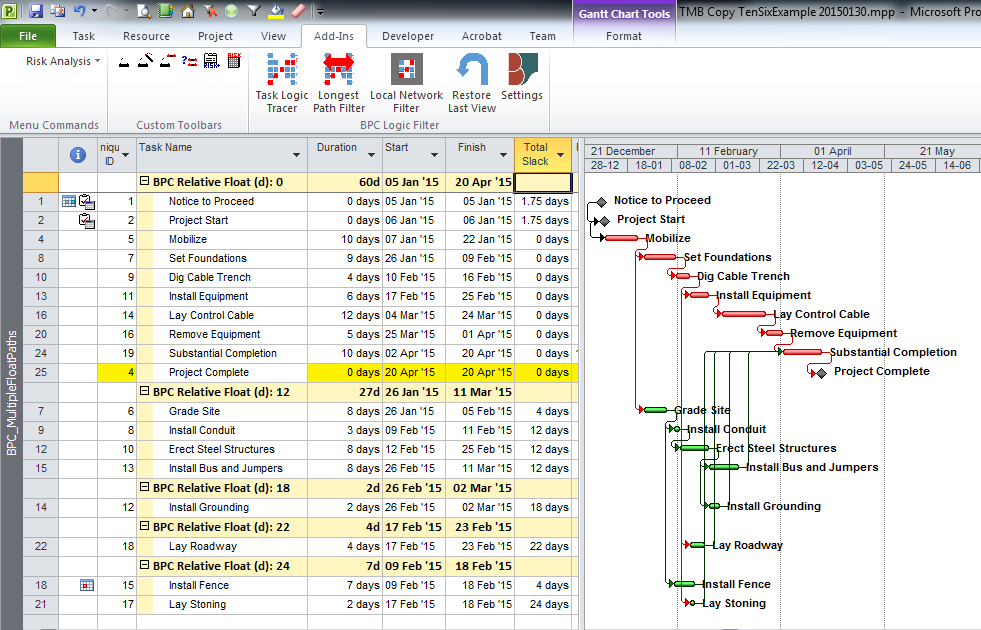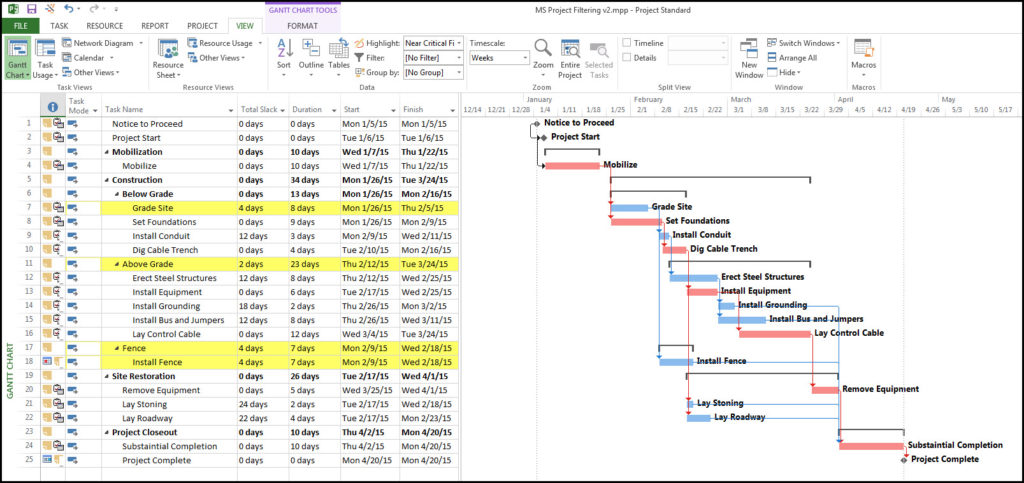Here I address the fundamental inability of MSP users – even supposed experts – to correctly analyze a logic-driven schedule.
While rooting around Planning Planet this morning, I stumbled across this link to an 8-month old blog entry from Ten Six Consulting: Monitoring Near Critical Tasks in Microsoft Project 2013 | Ten Six Consulting. In light of my work on BPC Logic Filter, this was a subject of interest to me. I started to reply on PP, but as my response grew I decided to transform it into an entry over here….
Overall I believe the article presents a perfect example of the fundamental inability of MSP users – even supposed experts – to correctly analyze a logic-driven schedule. The primary reason for this is the user community’s reliance on Total Slack as the sole indicator of a given task’s “criticality” or its inclusion on a particular logical path – all while continuing to use constraints, deadlines, and variable calendars.
As usual, the article is a well written and nicely presented illustration of a fairly elementary concept, i.e. generating and applying a “Near Critical Filter” to show only tasks with Total Slack values between 0.1 and 10 days. Ten Six then applied this filter to “clearly see all the tasks that are non-critical but in danger of becoming critical if they are delayed in any way.” Here is the resulting chart (taken from their article) with the four “Near Critical” tasks highlighted. The chart implicitly tells us that a Finish-No-Later-Than (2/22/15) constraint has been applied to the “Install Fence” task, reducing its Total Slack to 4 days. Now the Fence and its only predecessor (Grade Site) are highlighted as Near-Critical. (The TS=2 on the “Above Grade” summary task, also highlighted, seems to be a fluke of MSP’s screwy roll-up rule for TS; it reflects no logical relationship. [See Total Slack Calculation for Summary Tasks in Microsoft Project.])
So, if the fence is delayed by 5 days, is the project’s completion delayed? Clearly No; not according to this schedule. The fence is not Near Critical for the project. It merely has a constraint that may be violated (generating negative slack) if it slips too much. Since it is a common practice to represent such commitments with late constraints or deadlines, this example is fairly typical of a situation that occurs routinely in complex schedules with multiple contract milestones. It demonstrates why total slack is an unreliable indicator of the critical/near-critical path – i.e. the driving/near-driving path for project completion (or for anything else) –for all but the simplest projects.
There are some traditionalists in the scheduling profession who aim to preserve the sanctity of Total Slack (and Total Float in other tools) by prohibiting the use of any deadlines or late constraints in the schedule at all, regardless of contract commitments. The same group should also prohibit the use of variable task calendars, resource calendars, and any kind of resource leveling, since these can also invalidate their interpretation of total slack. I understand and empathize with this point of view – after all, without meaningful Total Slack (especially in MSP), the typical planner or analyst is reduced to hand-waving explanations when it comes to answering the tough questions. I’ve been there. Nevertheless, I also think alarm bells should ring and the schedule should bleed red whenever there is a forecast failure to meet a commitment. I advocate for methods other than setting aside 30 years of software development.
I spent a few minutes duplicating Ten Six’s schedule in MSP 2010 – thankful that they seem to be using the same (standard) example for the two articles published eight months apart. I think I got it close enough for illustrative purposes – with the main factors being a 4-day project work-week (M-Th), a 24-hour calendar on the first two milestones, and the aforementioned late constraint on the fence. Then I used BPC Logic Filter to trace the logic for the “Project Complete” task.
Here’s the resulting chart. It shows the driving path for project completion (i.e. the “Critical Path”) – at Relative Float of 0. The CP includes all the tasks with TS=0 plus the two project milestones which, because of their different calendars, have a different Total Slack value. The first “Near-Critical Path” is actually 12-days (not 4 days) away from driving the project completion, and it includes the “Grade Site” task with the (synthetically reduced) TS=4. The “Install Fence” task, also with TS=4, is 24 days away from driving the project completion.
I didn’t write BPC Logic Filter to overcome all the shortcomings of MSP; rather I wrote it to extract and present the logic-related information that is already there but which MSP does not show. In this case – as in most – it tells a more complete story than Total Slack alone.


